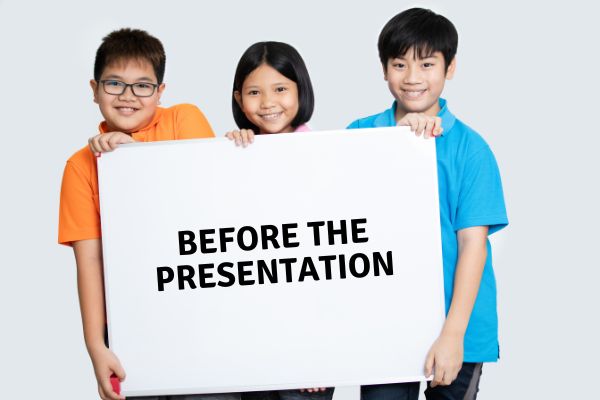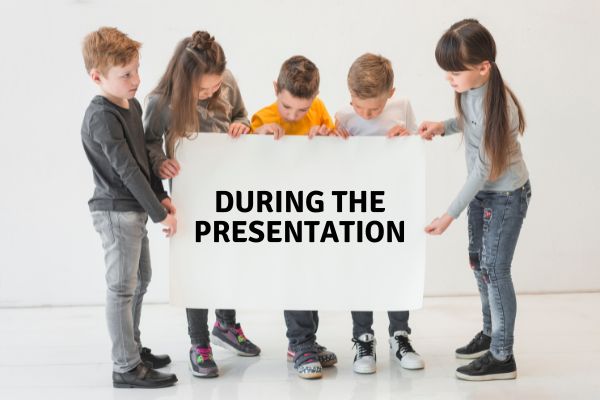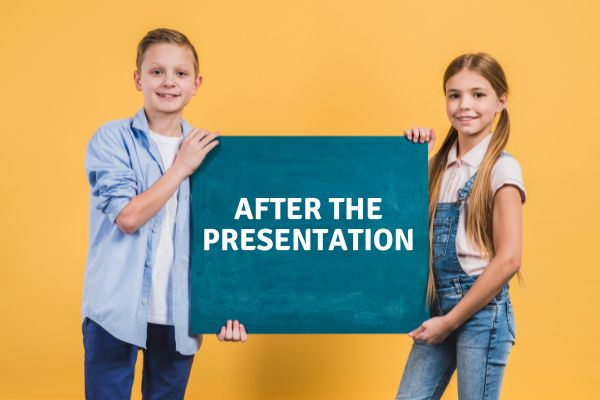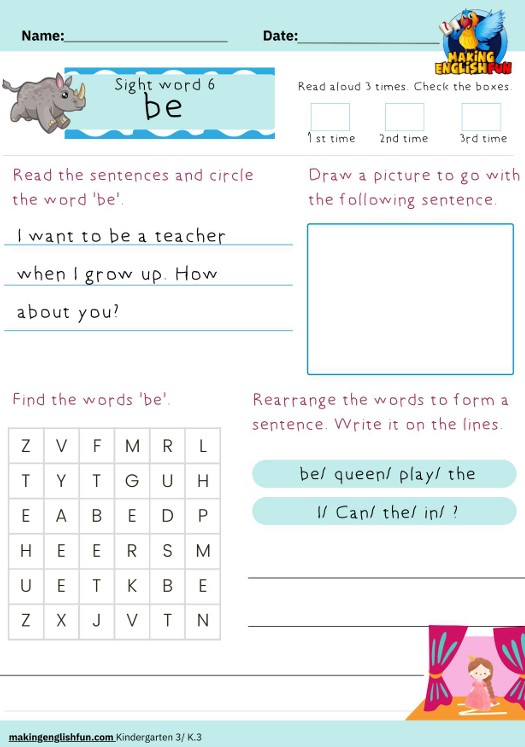18 Presentation Tips for Kids
Preparing for a presentation can feel like a big task, but it’s also an awesome opportunity to share knowledge and express creativity.
This guide is designed to help students step up their presentation game and feel more confident in front of the class.
We’ve put together a bunch of handy tips covering everything from choosing a topic to wrapping up the presentation with style.
- Teachers, these tips will be great tools to guide your students in crafting engaging and effective presentations.
- Students, these are your steps to becoming presentation pros!

Whether it’s managing nerves, keeping your audience engaged, or making your points clearly, these tips are here to help you shine.
Let’s get started and turn those presentation jitters into a round of applause!
We have a table of these tips at the end of the article to download you can give to your class, or use yourself.
Section 1: Before the Presentation
Before you even step in front of your audience, there’s plenty to do. From picking a topic you love to practicing your speech, these tips will help you get ready and set the stage for a fantastic presentation.

1. Choosing an Engaging Topic:
Picking a topic can be fun! It’s great when kids talk about something they love, like a hobby or a cool project they did. When kids are into their topic, their presentation naturally becomes more lively and interesting.
Presentation Tip: A good tip is to have a chat with them about what they enjoy or what they’ve been curious about lately. This way, they can find a topic that they’re really excited to share with others.
We actually have sets of presentation scripts ready to use to practice if you wish to get some ideas.
2. Research and Organizing Content:
Finding out cool stuff about their topic is like a treasure hunt for kids. Encourage them to look up information in books or online, but make sure they use websites that are just right for their age.
Presentation Tip: A fun tip is to use colorful sticky notes or draw a mind map to sort their ideas.
This makes it easier to see what they want to talk about first, next, and last. It’s like putting together pieces of a puzzle to tell a great story.
3. Designing Effective Visual Aids:
Making posters or slides can be a blast. Remind kids to keep things simple – big words they can read and neat pictures that show what they’re talking about.
Presentation Tip: A good trick is not to cram too much onto one page or slide.
Just a few key points and images are enough to make their presentation pop and help everyone understand better.
4. Rehearsing the Presentation:
Practice makes perfect! Instead of practicing all at once, breaking it up into shorter sessions can make it more doable and fun.
Presentation Tip: They can try speaking in front of a mirror, recording themselves, or even presenting to their stuffed animals or family.
This helps them get better at talking about their topic and feel more ready for the big day.
5. Managing Nervousness:
It’s totally normal to feel a bit jittery before presenting. Teach them to take deep breaths or think of something happy to calm those butterflies in their stomach.
Presentation Tip: Remind them that it’s cool to be a bit nervous, and everyone feels that way sometimes.
The more they practice in a friendly setting, the more they’ll feel like they can rock their presentation.
Section 2: During the Presentation
Now, it’s showtime! This is where all your preparation pays off. These tips will guide you on how to engage your audience, deliver your message clearly, and handle any surprises with confidence. Let’s make your presentation shine!

6. Confident Opening:
Beginning the presentation with confidence sets the tone. Encourage kids to start with something they’re genuinely excited about, like an interesting fact or a personal story related to their topic. This immediately captures the audience’s attention.
Presentation Tip: Practicing the opening lines several times can help them memorize and deliver them confidently.
Remind them that a strong and engaging start not only grabs attention but also boosts their confidence for the rest of the presentation.
7. Clear and Measured Speech:
Speaking clearly and at a comfortable pace is essential. A useful technique is to imagine speaking to someone at the back of the room, ensuring they speak loudly and enunciate each word.
Presentation Tip: Encourage them to take brief pauses, especially after key points, to let the audience absorb the information.
This also gives them a moment to gather their thoughts before moving on.
8. Engaging Eye Contact:
Eye contact is a powerful way to connect with the audience.
Presentation Tip: Teach kids to look around the room, making brief eye contact with different people.
It’s like having mini conversations within their presentation, which makes it more engaging and personal.
This technique can also help in reducing nerves as they focus on individual faces rather than the entire audience.
9. Effective Use of Visual Aids:
Visual aids are there to support, not dominate, the presentation. Kids should use them to highlight key points or explain complex ideas.
Presentation Tip: Teach them to glance at the aid for reference, then direct their attention back to the audience while explaining.
This ensures the audience focuses on their explanation rather than getting distracted by the visual aid.
10. Engage with the Audience
Audience engagement turns a presentation from a monologue into an interactive experience. Encourage students to connect with their audience by asking rhetorical questions, incorporating short activities, or simply by showing enthusiasm for their topic.
Involving the audience makes the presentation more dynamic and interesting.
Presentation Tip: Kids can ask a question, conduct a quick poll, or invite responses to a statement.
This not only keeps the audience engaged but also makes the presentation more interactive and enjoyable for the presenter.
11. Stay Calm and Composed
Keeping calm under the spotlight is key. Teach students techniques to manage presentation nerves, such as deep breathing or positive visualization. Remind them that it’s okay to pause for a moment to collect their thoughts during the presentation.
Presentation Tip: A good way to practice staying composed is through ‘distraction drills,’ where students present while facing minor, planned interruptions.
This helps them learn to maintain focus and composure, regardless of unexpected circumstances
12. Stand Straight
A good posture and standing straight are essential for a confident presentation. Encourage students to stand straight, as it not only improves voice projection but also displays confidence, if you display it you might just feel it as well.
Presentation Tip: An effective way to practice this is to set up an exercise where students speak to a ‘back row,’ ensuring they’re audible without shouting.
13. Projecting Voice:
Being heard clearly is essential. no mouse voices need here! While you don’t have to shout, though that might be funny!, you do have to get the message to the room, that might be a classroom or a school hall!
Presentation Tip: Encourage practicing in larger spaces to get comfortable with projecting their voice.
This helps ensure that their message is delivered clearly to everyone in the room, even those at the back.
14. Impactful Conclusion:
Ending on a strong note is crucial. Teach students to wrap up their presentations by summarizing the key points and reiterating the main message. Ending with impact leaves a lasting impression.
Presentation Tip: Encourage them to summarize key points or end with a thought-provoking question or statement.
Remind them that practicing their closing remarks can help in delivering a strong and memorable conclusion.
Section 3: After the Presentation
Great job, you’ve made it through! But there’s still a bit to learn. Reflecting on your presentation, gathering feedback, and recognizing your effort are key steps to improving and celebrating your hard work. Let’s wrap up and look ahead!

15. Gathering Feedback:
Feedback is a valuable tool for improvement.
Presentation Tip: Encourage kids to ask for specific feedback from peers, teachers, or family members.
Questions like, “What part did you like best?” or “What could I do better next time?” can provide insightful responses. Assure them that receiving feedback is a positive experience and a chance to learn.
16. Personal Reflection:
Reflecting on their own performance is as important as receiving external feedback.
Presentation Tip: Encourage them to think about what parts of the presentation they felt good about and what parts were challenging.
This self-awareness helps them recognize their strengths and identify areas for improvement.
17. Incorporating Feedback:
Using the feedback received effectively is key to growth.
Presentation Tip: Help them understand how to apply constructive criticism to future presentations. This might involve working on speaking louder, making more eye contact, or improving their visual aids.
This process turns feedback into actionable steps for improvement.
18. Acknowledging Effort:
Recognizing the effort and bravery involved in presenting is crucial.
Presentation Tip: Celebrate their hard work and courage, regardless of the presentation’s perfection.
This acknowledgment fosters a positive attitude and encourages them to take on new challenges in the future.
Table of Presentation skills and Tips for Students
| Aspect of Presentation | Why It’s Important | Tips to Achieve It |
|---|---|---|
| Choosing a Topic | Makes your presentation interesting for you and the audience. | Think about your hobbies or something cool you learned recently. |
| Research and Organizing | Helps you understand your topic better and makes your presentation flow smoothly. | Use sticky notes for ideas and create a mind map to plan your talk. |
| Designing Visual Aids | Makes your presentation more engaging and helps explain your points. | Keep it simple: use big text and a few clear pictures or charts. |
| Rehearsing | Builds your confidence and helps you remember what to say. | Practice in front of a mirror or family, and try to do it in small parts. |
| Managing Nervousness | Keeps you calm so you can present your best. | Take deep breaths and think of something fun; remember, it’s okay to be a bit nervous. |
| Confident Opening | Grabs the audience’s attention right from the start. | Start with something fun or interesting about your topic. |
| Clear and Measured Speech | Makes sure everyone can understand and follow your presentation. | Pretend you’re talking to a friend at the back of the room. |
| Engaging Eye Contact | Connects you with your audience and makes your talk more personal. | Look at different people in the room as if you’re chatting with them. |
| Effective Visual Aids | Supports what you’re saying without taking over. | Use them to show something interesting, but don’t just read from them. |
| Audience Interaction | Makes your presentation fun and keeps everyone interested. | Ask a question or do a quick poll. |
| Maintaining Focus | Ensures you cover all your important points. | Use cue cards with key points as reminders. |
| Handling Distractions | Shows you’re in control and keeps your presentation on track. | Stay calm, pause if needed, then continue where you left off. |
| Impactful Conclusion | Leaves a lasting impression on your audience. | End with a cool fact or question about your topic. |
| Good Posture and Stance | Shows confidence and helps your voice carry. | Stand like a superhero; it feels funny but really works! |
| Projecting Voice | Ensures everyone can hear you clearly. | Practice speaking in a big room or outdoors to get used to projecting your voice. |
| Gathering Feedback | Helps you learn what went well and what to improve. | Ask classmates and teachers what they liked and what you can do better. |
| Personal Reflection | Helps you understand your strengths and what to work on. | Think about what parts you liked and what parts were tricky for you. |
| Incorporating Feedback | Improves your skills for next time. | Use the advice you get to make your next presentation even better. |
| Acknowledging Effort | Makes you feel good about trying and encourages you to keep going. | Give yourself a pat on the back for your hard work, no matter how it went! |
This table can be a handy reference for students to understand the key aspects of a good presentation. We have a printable version on the link below and if you want the editable on you can email us on info@makignenglishfun.com
Conclusion
Teachers and students, armed with these tips, you’re now ready to tackle any presentation challenge that comes your way.
- Students, remember that every presentation is a chance to grow and showcase your unique ideas. Don’t be afraid to experiment with different styles and approaches – find what works best for you.
- Teachers, continue encouraging your students to use these strategies, offering support and guidance as they develop their skills.
Each presentation is a stepping stone towards becoming more confident and effective communicators. So, the next time you’re up for a presentation, take a deep breath, embrace these tips, and step confidently onto the stage. You’ve got this!







